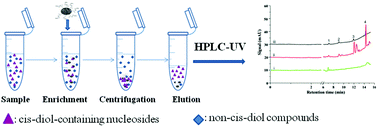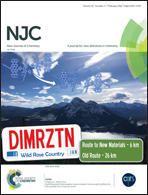A boronate-decorated porous carbon material derived from a zinc-based metal–organic framework for enrichment of cis-diol-containing nucleosides†
Abstract
In this study, a new boronate affinity porous carbon absorbent derived from a home-made zinc-based metal–organic framework (Zn-MOF) was successfully fabricated. This absorbent was prepared by calcination of the Zn-MOF material and further modified with boronic acid groups. The resulting material was used to selectively enrich cis-diol-containing nucleosides in complex samples, and it exhibited superior binding capacity (26.0 mg g−1 for adenosine). The material coupled with high-performance liquid chromatography was successfully applied to analyze four cis-diol nucleosides (cytidine, uridine, guanosine, and adenosine) in injection and cell samples. Under optimized conditions, the method exhibited excellent extraction performance. The limits of detection of the method were 4.73–14.6 μg L−1 for the four nucleosides based on the signal-to-noise ratio of 3 : 1. Spiked recoveries were found between 88.2 and 108.2% (the relative standard deviation was in range of 1.3–11.3%, n = 3). This study improved the selectivity of porous carbon derived from MOF material and presented a promising thought for effective capturing of analytes on MOF materials.



 Please wait while we load your content...
Please wait while we load your content...